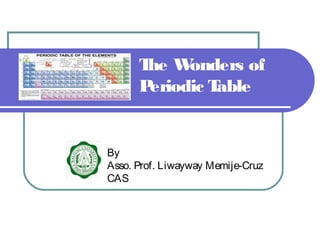
Wonders of Periodic Table
- 1. The Wonders of Periodic Table By Asso. Prof. Liwayway Memije-Cruz CAS
- 2. Periodic Table is the tabular arrangement of all the chemical elements which are organized based on atomic numbers, electronic configurations and existing chemical properties.
- 3. Development of Periodic Table As early as 1800, chemists began to determine the atomic weights of some elements with fair accuracy. Several attempts were made to classify the elements on this basis.
- 4. Johann Wolfgang Dobereiner He classified the elements in groups of 3 called triads, based on similarities in properties and that the atomic mass of the middle member of the triad was approximately the average of the atomic masses of the lightest elements. State of the Environment: Issues and Concerns
- 5. John A. Newlands (1863) He arranged the elements in the order of increasing atomic mass. The eight elements starting from a given one is a kind of repetition of the first like the eight notes of the octave of music and called it the law of octaves.
- 6. Lothar Meyer He plotted a graph showing an attempt to group elements according to atomic weight.
- 7. Dmitri Mendeleyeev (1869) He worked out a Periodic Table of Elements were the elements were arranged in the order of increasing atomic weights with a regular repetition (periodicity) of physical and chemical properties.
- 8. Henry Moseley He arranged the elements in the order of increasing atomic numbers, which relates that the properties of the elements are periodic functions of their atomic numbers. This is known as the Modern Periodic Law.
- 9. Classification of elements in the Periodic Table 1. Representative Elements are the elements in A Group/ Family. The term representative element is related to stepwise addition of electrons to the s and p sub levels of the atoms. Elements belonging to the same group or family have similar properties. 2. Noble Gases or Inert Gases are the elements in the last group with completely filled set of s and p orbitals. 3. Transition Elements are the elements in the columns IB - VIIIB which are called the B Group/Family. Take note that they start with IIB up to VIIB, which have 3 columns and then end with IB and IIB. These sequences, which contain 10 elements each, are related to the stepwise addition of the 10 electrons to the d sub level of the atoms. These elements are metallic-dense, lustrous, good conductor of heat and electricity and in the most cases are hard. They form the many colored compounds and form polyatomic ions like Mn04 and CrO4. 4. Inner Transition Elements are the 2 additional horizontal rows below composed of 2 groups of elements which were discovered to have similar characteristics as Lanthanum in the 6th period called Lathanoids (Rare Earth Metals) and Actinium (Heavy Rare Elements). The Lanthanoids are all metals while the Actinoids are all radioactive. All the elements after Uranium are produced artificially by nuclear reactions.
- 10. Positions of metals, nonmetals and metalloids in the Periodic Table Metals are at the left and in the center of the Periodic Table. Atoms of metals tend to donate electrons. Nonmetals are at the far right and toward the top of the Periodic Table. Atoms of non-metals tend to accept electrons. Metalloids or borderline elements are elements that to some extent exhibit both metallic and nonmetallic properties. They usually act as electron donor with metals and electron acceptor with non-metals. These elements lie in the zigzag line in the Periodic Table.
- 11. Atomic size
- 12. Exercise: Consider the atoms of Period 3: Na 2e 8e 1e Mg 2e 8e 2e Al 2e 8e 3e Consider the electronic configuration of Group IA elements: Na 2e 8e 1e K 2e 8e 8e 1e Rb 2e 8e 18e 8e 1e Cs 2e 8e 18e 18e 8e 1e Fr 2e 8e 18e 18e 18e 8e 1e
- 13. When an atom losses or gains electron, it becomes a positively/negatively charge particle called ion.
- 14. Ionization energy is the amount of energy required to remove the most loosely bound electron in a gaseous atom or ion to give a positive (+) particle of cation. Going across a period, there is an increase in the ionization energy due to the removal of electron in each case is at the same level and there is a greater nuclear charge holding the electron.
- 15. Electron affinity is the energy given off when a neutral gaseous atom or ion takes in an electron. Negative ions or anions are formed.
- 16. Electronegativity is the tendency of an atom to attract shared electrons to itself when it forms a chemical bond with another atom.
- 17. Summary of the Trends in the Periodic Table
- 18. Thank you!
